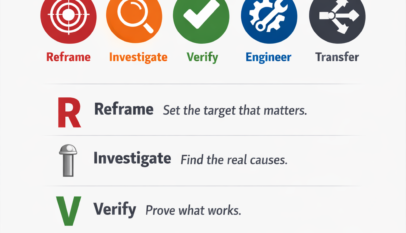Introduction Kaizen events are an important tool for continuous improvement in organizations. These events help teams to identify problems, analyze root causes, and develop solutions that can be implemented quickly. The success of a kaizen event depends on careful planning, execution, and follow-up. In this paper, we will discuss the seven simple steps involved in kaizen event planning.
Step 1: Define the Problem and Goal. The first step in kaizen event planning is clearly defining the problem and goal. This requires a thorough understanding of the process and the issues that must be addressed. The problem statement should be specific and measurable, and the goal should be achievable within the event’s timeframe. For example, a problem statement could be, “We have excessive scrap in our manufacturing process.” The goal could be “Reduce scrap by 50% within five days.”
Step 2: Identify the Team. The second step is identifying the team involved in the kaizen event. The team should consist of individuals who have knowledge and experience in the process being improved. It should also include representatives from all areas affected by the process, including operators, supervisors, and managers. For example, a kaizen event to reduce scrap in manufacturing might include the production manager, quality manager, and several operators.
Step 3: Develop the Agenda. The third step is developing the kaizen event’s agenda. The agenda should include specific activities and timelines for each day of the event. This should include time for team meetings, process observations, data collection, analysis, and solution development. For example, the agenda for a five-day kaizen event might include one day for process observations and data collection, two days for analysis and solution development, and two days for implementation and follow-up.
Step 4: Prepare the Team. The fourth step is to prepare the team for the kaizen event. This includes providing training on kaizen principles, improved process, and any tools or techniques used during the event. Setting expectations for the event, including the goals and timeline, is also essential. For example, the team might receive training on using fishbone diagrams for root cause analysis, and expectations might be set for a daily progress report.
Step 5: Conduct the Kaizen Event. The fifth step is to conduct the kaizen event. This involves following the agenda, collecting and analyzing data, and developing solutions. It is vital to involve all team members in the process and to encourage open communication and collaboration. For example, during the event, the team might use a fishbone diagram to identify the root causes of scrap and then develop solutions using a brainstorming session.
Step 6: Implement Solutions. The sixth step is to implement the solutions developed during the kaizen event. This should be done quickly to maximize the event’s impact. Monitoring the process after implementation is important to ensure the solutions work as intended. For example, after the kaizen event, the team might implement a new process for scrap reduction and monitor scrap levels daily to ensure that the process is effective.
Step 7: Follow-Up and Continuous Improvement. The final step in kaizen event planning is follow-up and continuous improvement. This involves tracking progress against the goals set for the event and identifying opportunities for further improvement. Recognizing the team’s achievements and providing feedback on the event are also important. For example, the team might meet weekly for a month after the event to review progress and identify any additional improvements that can be made.
Conclusion Kaizen events are an important tool for continuous improvement in organizations. By following the seven simple steps outlined in this paper, teams can plan and execute successful


















